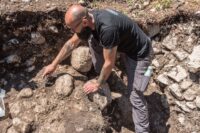 A cremation burial containing bronze jewelry and rare surviving textile fragments has been unearthed from the Early Iron Age (800-550 B.C.) burial ground at Hallstatt, Austria. Grave goods discovered in the burial include spiral discs of bronze wire placed on top of the cremated remains that were likely fibulae (large brooches used to fasten garments), a massive ribbed arm bangle, the blade of a bronze knife with fragments of the wooden handle still attached, a piece of sheet iron from a belt buckle and an animal bone from a food offering.
A cremation burial containing bronze jewelry and rare surviving textile fragments has been unearthed from the Early Iron Age (800-550 B.C.) burial ground at Hallstatt, Austria. Grave goods discovered in the burial include spiral discs of bronze wire placed on top of the cremated remains that were likely fibulae (large brooches used to fasten garments), a massive ribbed arm bangle, the blade of a bronze knife with fragments of the wooden handle still attached, a piece of sheet iron from a belt buckle and an animal bone from a food offering.
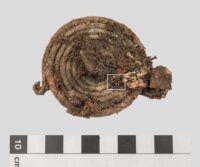
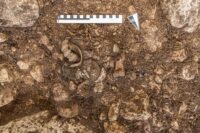 The finds were densely packed into the grave, and it was only when the objects were detached and examined closely that archaeologists recognized the surviving traces of fabric on the undersides of the spiral discs. These might be the first archaeological evidence that textile pouches were used to contain cremated remains for burial. Urns were used in other cemeteries of the period, but are very seldom found in the Hallstatt burial ground. The cremated remains are so compact, however, that archaeologists have long suspected they were buried in organic bags whose fabric or leather had decayed over the millennia.
The finds were densely packed into the grave, and it was only when the objects were detached and examined closely that archaeologists recognized the surviving traces of fabric on the undersides of the spiral discs. These might be the first archaeological evidence that textile pouches were used to contain cremated remains for burial. Urns were used in other cemeteries of the period, but are very seldom found in the Hallstatt burial ground. The cremated remains are so compact, however, that archaeologists have long suspected they were buried in organic bags whose fabric or leather had decayed over the millennia.
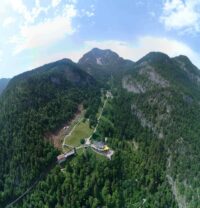 Hallstatt is the site of a salt mine that drew seasonal visitors going back 7,000 years ago to the Neolithic. They attempted to extract the salt using picks made of deer antlers and stone axes, but systematic mining of the salt began in the 16th century B.C. Three prehistoric mines have been identified amidst the warren of subterranean tunnels, one Bronze age, one from the Early Iron Age, one from the Late Iron Age.
Hallstatt is the site of a salt mine that drew seasonal visitors going back 7,000 years ago to the Neolithic. They attempted to extract the salt using picks made of deer antlers and stone axes, but systematic mining of the salt began in the 16th century B.C. Three prehistoric mines have been identified amidst the warren of subterranean tunnels, one Bronze age, one from the Early Iron Age, one from the Late Iron Age.
High in the Salzberg Valley is a burial ground connected to the mine that is one of the most important prehistoric burial grounds in Europe. The burial ground was in use from 850 B.C. through about 350 B.C. Luxury goods imported from all over the known world were buried with the 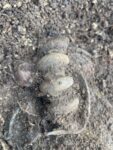 dead, a testament to the great wealth and far-reaching trade relations generated by the mining of salt at Hallstatt. The variety, quality and distinctiveness of the artifacts found there prompted researchers to use “Hallstatt” as the name of a culture and an entire period of European prehistory (8th-5th centuries B.C.).
dead, a testament to the great wealth and far-reaching trade relations generated by the mining of salt at Hallstatt. The variety, quality and distinctiveness of the artifacts found there prompted researchers to use “Hallstatt” as the name of a culture and an entire period of European prehistory (8th-5th centuries B.C.).
The Iron Age burial ground was first discovered in 1846 by Johann Georg Ramsauer, the director of the salt mine who had worked there since he was a 13-year-old apprentice and rose through the ranks to become Bergmeister (mining master) by the age of 36. Then, after discovering the first grave in a gravel pit, with zero training or education he transformed himself into a meticulous accidental archaeologist. From 1846 until 1863, he directed the excavations of the Hallstatt cemetery, and documented everything he found with incredibly detailed watercolors.
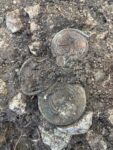 In 17 years of excavations, Ramsauer and his crew unearthed 980 graves containing almost 20,000 objects. He thought they had found all that there was to be found, but new graves were discovered in the 1930s and the Natural History Museum has found many more since it began annual excavations of the burial ground in 1992. As of now, more than 1,500 graves have been unearthed and documented, and the discovery of the latest grave suggests the burial ground is even larger than previously realized. Archaeologists estimate there may be another 4,000-5,000 unexplored graves at the site.
In 17 years of excavations, Ramsauer and his crew unearthed 980 graves containing almost 20,000 objects. He thought they had found all that there was to be found, but new graves were discovered in the 1930s and the Natural History Museum has found many more since it began annual excavations of the burial ground in 1992. As of now, more than 1,500 graves have been unearthed and documented, and the discovery of the latest grave suggests the burial ground is even larger than previously realized. Archaeologists estimate there may be another 4,000-5,000 unexplored graves at the site.